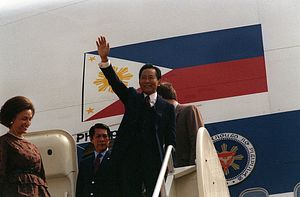Late Philippine President Ferdinand Marcos, who ruled from 1965-1986, including two decades of dictatorship, was finally laid to rest at Heroes’ Cemetery, also known as Libingan ng mga Bayani, in Taguig, Metro Manila on Friday. This surprise move came just ten days after the Supreme Court ruled that there was legally no obstacle to burying the controversial late president at the national cemetery. The burial has caused both praise and criticism, which indicates the existence of a persistent, unsettled controversy and the deep divide within the country on how Marcos should be remembered, even after 30 years of democratization.
In 1986, Marcos and his family fled to Hawaii amid massive “People Power” protests against the regime that finally ended his dictatorship and restored democracy to the Philippines. Three years later, he died in Honolulu, never having had the chance to step back onto his native soil. Initially, his remains were not allowed to be buried in the Philippines. After a deal was agreed upon by both ends – the then-Ramos administration and the Marcos family – his body was finally returned to the country in 1993 and laid to rest in Ilocos Norte, Marcos’ home province. It was also a part of the deal of his “return” that Marcos would never receive full honors as the late president, including a national funeral and burial at Heroes’ Cemetery.
Though a compromise was made, it does not necessarily mean that Marcos’ family and loyalists gave up their hope. In fact, it was their long-held dream that one day Marcos would be buried at this cemetery as a late president and as a national hero who fought for the country during World War II.
One of those who opened the door for this dream was President Rodrigo Duterte. During his campaign for the presidency, Duterte openly declared that he would allow the burial of Marcos at Heroes’ Cemetery. Accordingly, he ordered permission for the burial once he was elected. As a response to this move, critics, including victims of Marcos’ reign, filed seven petitions to prevent burial at the Heroes’ Cemetery. However, the Supreme Court recently judged, by a count of nine to five with one inhibition, that there is legally no reason to bar the Duterte administration from allowing Marcos’ burial at the cemetery.
In one sense, the issue is certainly a matter of legal interpretation, and there are debatable questions such as whether Marcos really fought against the Japanese during the war. More importantly, however, the recent controversies evolving around this matter indicate the deep divide in the country regarding how Marcos and his era should be remembered. Marcos’ evaluation has not yet necessarily been settled, and it is not rare to encounter discourse referring to the Marcos reign as the “glorified past,” partly due to the despondency of the country’s 30 years of democracy.
The democratization brought about by “People Power,” which ended Marcos’ authoritarian regime, has been the one of the proudest landmarks for the Philippines and its people. During the approximately two decades of dictatorship, which began with the declaration of martial law, political opponents and those against the regime were severely oppressed. The democratic process was suspended and manipulated by the Marcos regime. Democracy has a particular meaning for the Philippines and all the more for this past history in a region where non-democratic regimes are still vigorously surviving.
However, from another perspective, the fruits of 30 years of democracy, particularly in a practical sense, are debatable. The economy has not developed as steadily as expected and often has stagnated. Even during the Aquino III period, which saw stable economic growth, the gap between the rich and the poor did not narrow. In other words, the majority of people have still been left behind in terms of development, even under the democratic regime. Furthermore, the deterioration of security and prevalence of illegal drugs may have exposed the negative side of a less controlled society. It is unfair to blame this on democracy itself, but it is also true that this dissatisfaction has caused some people to remember the Marcos regime as the “good old days.”
If we take this perspective, recent political phenomena in the Philippines could be understood in the same context – the landslide victory of Duterte, who has authoritarian inclinations, and the rise of Bongbong Marcos, a son of the late president, who is gaining nationwide popularity and placed second in the recent race for the vice presidency. The controversy caused by Marcos’ burial again has revealed the deep divide within the country regarding the Marcos regime and the potential discontent over the past three decades of democracy. In today’s situation, in which there is speculation of another period of martial law under Duterte’s government, this divide could potentially affect the course of Philippine politics. Though Marcos might finally be laid to rest, the major controversy over his legacy is still unsettled.
Michio Ueda is an independent scholar based in Tokyo. As a political scientist, his main focus has been party politics and elections in Southeast and East Asian countries. Michio received an LL.B. from the University of Tokyo and an M.A. distinction in Southeast Asian Studies from the University of Wisconsin-Madison, where he studied as a Fulbright fellow. He previously worked in the Japan Ministry of Defense.

































